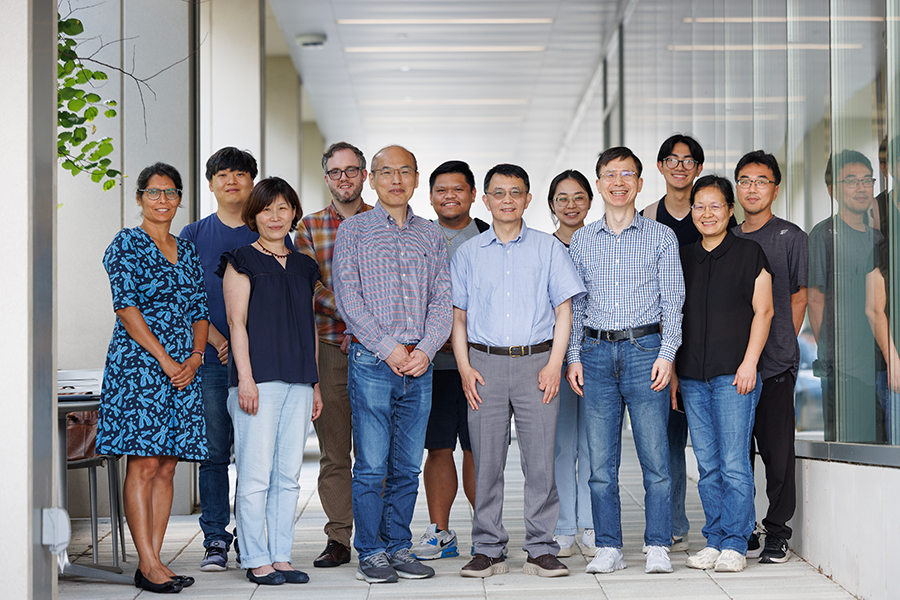
Over 50 million people in the United States suffer from some sort of chronic pain. For many, relief comes in the form of opioids, but opioids come with their own set of problems including addiction and overdose. While the number of overdoses has declined over the past decade, it still poses significant health concerns, especially with the rise of synthetic opioids and fentanyl.
A multidisciplinary team across Duke University is developing a promising new approach to pain management using adenosine, a naturally occurring compound in the human body that can help regulate pain, inflammation and seizure activity. Seok-Yong Lee, PhD, George Barth Geller Distinguished Professor of Molecular Biology and professor of biochemistry; Ru-Rong Ji, PhD, William Maixner Professor of Anesthesiology; and Jiyong Hong, PhD, professor of chemistry, developed a non-opioid pain-relieving compound that inhibits equilibrative nucleotide transporter subtype 1 (ENT1), which is the main adenosine transporter in humans.
“The idea is that if you inhibit the ENT1 transporter,” Lee said, “you elevate the concentration of adenosine, and it can suppress pain.” This could help reduce our reliance on these addictive opioid pain medications.
Using their shared expertise in chemistry, pain research, and biochemistry, Hong, Ji, and Lee designed a new ENT1 inhibitor and determined the atomic structure of the inhibitor-ENT1 complex to validate their design.
“We tested the compound in various mouse models of pain, including inflammatory pain and neuropathic pain,” Lee said, “and our compound has very good efficacy in suppressing pain, especially neuropathic pain.”
In fact, their initial results show that this compound has a higher efficacy than the current most common neuropathic pain medication, gabapentin, which works by mimicking a naturally occurring chemical in the body that calms nerve activity.
Neuropathic pain is complex, often having a variety of symptoms, which makes it difficult to treat. Nerve pain can be extremely persistent and travel around the body, affecting several areas of the nervous system and making traditional pain medication less effective.
So far, their results show the ENT1 inhibitor compound not only works better but is also less addictive with fewer side effects compared to opioid medications, which can cause respiratory suppression, cognitive impairment, and constipation. Unlike opioids where the body can build up a tolerance to it, causing patients to have to take more and more, the ENT1 inhibitor works the opposite: “In animal models,” Ji said, “we see accumulation of the inhibitor’s analgesic actions after repeated administration, which provides enhanced energies and efficacies.”

“That means,” Hong added, “that you could be able to take less of it over time or stay at the same level and not have to worry about it not working.”
While they are still in the early stages and it’s too soon to make any big promises on replacing all opioids, they have shown proof of concept of this new target for pain management.
Their findings helped them secure a two-year grant from the National Institutes of Health Helping to End Addiction Long-term (HEAL) initiative. Opioid use disorder continues to claim tens of thousands of lives every year in the United States. By targeting a mechanism that doesn’t involve opioid receptors, the team hopes to be one step closer to providing a safer, non-addictive alternative for managing pain.
“Pain comes in many different forms and is not well understood. We believe our contribution will help provide a different way, a different mechanism, a new target that could actually have better pain efficacy.” — Seok-Yong Lee, PhD
As part of their HEAL initiative funding, the team plans to start a small center focused on non-opioid translational pain management to continue their efforts. “We are making progress and have filed a patent,” Lee said. The next step will include improving the potency and selectivity of this ENT1 inhibitor and learning more about any potential side effects this compound may cause.
“Pain comes in many different forms and is not well understood,” Lee said. “We believe our contribution will help provide a different way, a different mechanism, a new target that could actually have better pain efficacy.”